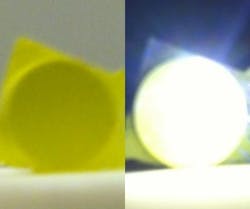UCSB laser-plus-phosphor white lighting is efficient and stable
Santa Barbara, CA--Combining a blue-emitting indium gallium nitride (InGaN) LED with a yellow YAG phosphor has produced one of most successful commercial photonic devices ever—the white-light LED. But there is a problem: InGaN LEDs suffer from efficiency droop, in which their efficiency at high optical output is lower than that for low optical outputs. However, another InGaN light source—the blue-emitting laser diode—does not suffer from this problem. As a result, researchers at University of California, Santa Barbara (UCSB), led by material scientists Kristin Denault and Michael Cantore, have combined laser diodes with inorganic phosphors to create efficient, stable sources of white light.1
Other forms of white-light laser
A bit of background: Other laser setups have also been, and are being, considered for use as white-light sources. For example, four lasers of different colors were combined to make a lighting-oriented white-light source by researchers at the University of New Mexico, Sandia National Laboratories (both of Albuquerque, NM), and the National Institute for Standards and Technology (NIST; Gaithersburg, MD); the pulsewidth-modulated laser source was preferred by test subjects as a white-light source over both warm and cool white LEDs.
BMW has been working at least since 2011 on combining blue-emitting laser-diode light with a phosphor to create efficient white light for car headlights; however, no BMW cars yet have laser-based headlights.
Supercontinuum lasers, which produce white light from the nonlinear interaction of ultrafast laser pulses with optical fiber, are used in research and the medical arena (for OCT and other uses), and can replace broadband light sources, but are too expensive for use as general indoor and outdoor lighting.
Similarly, in a setup built by Taiwanese researchers, a near-UV laser was used to pump a fiber with a sapphire core, producing white light to be used for OCT, as well as for fluorescence microscopy and flow cytometry. This approach is also presumably too expensive for use as general lighting.
The UCSB approach
To create white light, the group at UCSB uses blue or near-UV laser diodes in combination with a yellow YAG phosphor or a combination of red-, green-, and blue-emitting phosphors. Two arrangements produced cool white light with a color-correlation temperature (CCT) of 4400 K using a blue laser diode, and warm white light with a CCT of 2700 K using a near-UV laser diode; the color-rendering indices (CRIs) were 57 and 95 and luminous efficacies were 76 lm/W and 19 lm/W, respectively. (The CRI of 95 is excellent, and would likely be indistinguishable from the ideal blackbody light curve by most people; the CRI of 57 is far from ideal.)
The cool-white source emitted 252 lm, while the warm-white source produced 53 lm. The researchers also achieved a variety of other color temperatures with high color rendition, broadening the range of applications for these new lights, notes Kristin Denault. Luminous efficacies will rise with improvements in blue and UV laser diodes, inorganic phosphors, and packaging optics.
It seems that BMW and UCSB are pursuing similar approaches; perhaps BMW will someday benefit from the research at UCSB.
Source: http://www.eurekalert.org/pub_releases/2013-09/aiop-bll092613.php
REFERENCE:
1. Kristin A. Denault et al., AIP Advances 3, 072107 (2013); http://dx.doi.org/10.1063/1.4813837
About the Author
John Wallace
Senior Technical Editor (1998-2022)
John Wallace was with Laser Focus World for nearly 25 years, retiring in late June 2022. He obtained a bachelor's degree in mechanical engineering and physics at Rutgers University and a master's in optical engineering at the University of Rochester. Before becoming an editor, John worked as an engineer at RCA, Exxon, Eastman Kodak, and GCA Corporation.

